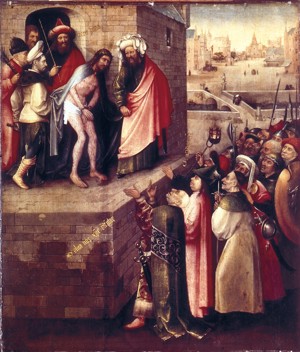Ecce Homo

“Ecce Homo” by Hieronymus Bosch, circa 1450
This means “behold the man” in Latin. It was used by Pontius Pilate when presenting Jesus to the crowds just before his execution. This moment has become common in art, as a depiction of Jesus with a crown of thorns.
Colloquially, it’s become a phrase which represents sacrifice, humility, or the basic simplicity of an unadorned human being.
The phrase is used as the title of many depictions of the moment.
Why I Looked It Up
In Why We Drive:
Perhaps suicide is a bad example to invoke, so here is another. When Captain Sully landed that airplane on the Hudson River, relying only on his hardwon skill and first-hand knowledge of airplanes, I believe the reason the whole country was electrified is that this presented a counter-image to the ideal that has been marked out for us. It was an ecce homo moment, here is a human being.